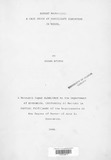| dc.description.abstract | The Government of Kenya has been keen on reducing the country's dependence on coffee, tea and petroleum as the main sources of foreign exchange. Kenya's petroleum exports contain little value added as the crude oil is imported whereas the growth in coffee and tea exports is often very minimal due to the low income elasticity of demand for coffee and tea. Since 1976, the Kenya Government has through its Kenya External Trade Authority (KETA) been playing an active part in the promotion of handicraft exports in Kenya. However, very little is known about the exporters, their problems and factors explaining for the varying levels of export sales amongst the handicraft exporters. The reason for this is that there has been very limited research on handicrafts in Kenya. Lack of adequate time series data does not allow an empirical analysis be made into the factors affecting handicraft exports from Kenya.
This study is an exploratory one, it makes a diagnosis of the problems facing Kenya's, handicraft exports and attempts at solutions based on the theoretical concepts of the product life cycle and the export cycle. It is concerned with the efforts that should be undertaken to avoid future fluctuations in Kenya's handicraft exports. It also suggests measures to cope with the stiff competition now prevailing in the international market.
V
Using Ordinary Least Squares, the study analyses the variation in export sales amongst the handicraft exporting firms in Kenya. As a result, the differences in levels of marketing efforts, experience in exporting handicrafts and institutional support from the KETA, were found to be explaining for a significant proportion of the variation in export sales amongst the firms.
The main finding of the study is that export sales are positively correlated with the proxy variables used in the study for levels of marketing effort, experience and institutional support from the KETA. The proxy for experience in exporting handicrafts, was found to have the greatest impact on export sales. However, the impact of the proxy for institutional support from the KETA was found to be statistically insignificant. This study however, underscores the importance of enhancing the exporters' ability to undertake successful promotional ventures aimed at the foreign markets | |

